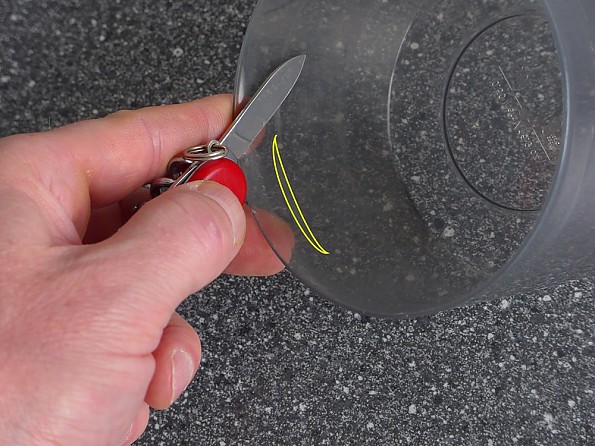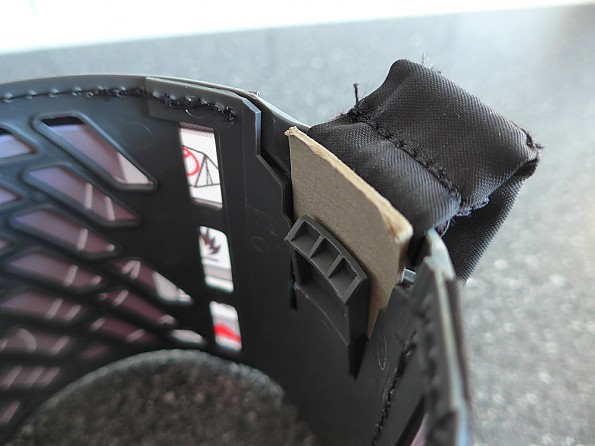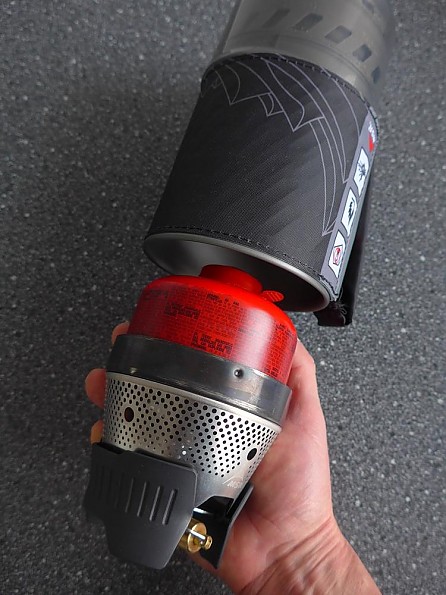MSR WindBurner Personal Stove System

If your idea of a pack stove is a tool for boiling water then read on as the MSR WindBurner does a brilliant job of it with only a little room for improvement.
Pros
- Sips fuel
- Works when cold
- Works in the wind
- Boils water crazy fast
Cons
- No built-in igniter
- Insulated cozy slips
- No protective storage bag
- Handle leads a bit to be desired
 Mountain Safety Research (MSR) has been around since 1969. It was founded by Larry Penberthy; an engineer, professional inventor and lifelong mountaineer bent on making everything about the experience safer and better. Enjoy the very interesting history of MSR here https://www.msrgear.com/msr-our-history.html.
Mountain Safety Research (MSR) has been around since 1969. It was founded by Larry Penberthy; an engineer, professional inventor and lifelong mountaineer bent on making everything about the experience safer and better. Enjoy the very interesting history of MSR here https://www.msrgear.com/msr-our-history.html.
The Windburner Personal Stove System is one of their stove offerings, and seems designed primarily for those who boil water to make hot beverages and rehydrate meals. That is what I purchased it for and how I will be reviewing it.

"Stove System" is not just some catchy phrase, this thing is just that. As you can see above, the pot that attaches to the burner has a built in heat exchanger. That, together with the radiant burner, wastes a very minimal amount of heat while also doing a fantastic job of shielding itself from the wind. No wasted heat equals no wasted fuel and this thing uses very little fuel.
The pot has measure marks on the inside. It attaches to the burner and comes off easily without any fuss. Simply set it on the burner and give it a twist to attach or remove. Those little dimples around the burner, visible in the photo, act as a lock mating the two pieces together. There is a little play between them when connected, but they remain securely attached when in use. Also included is a small plastic tripod that attaches to the bottom of the fuel canister. It attaches just as easily as the pot to the burner and adds stability to the whole apparatus. There is a plastic lid for the pot. The lid has a pour spout and can also be used as a strainer if desired.
There is no built-in igniter and this will be a sore point for some. I found a butane lighter works best. Safety matches also did a fine job. Turn on the valve, flick your BIC, and you're ready to rumble... and rumble it will. In about two minutes. This thing is fast and the boil is furious. Rapid is an understatement. In fact, do keep an eye on it as it as it will boil away a significant amount of your water in a very short time; and no one likes a partially rehydrated meal.
When ready, simply grasp the cup with one hand and the plastic part of the burner with the other to separate with a twist. The plastic around the burner stays cool, but do be careful of the metal parts as they will be hot.
We are now to the part of the stove I feel could use improving. The insulated cozy around the pot. As noted by others it slips up and down and could fall low enough to be melted by the burner; so I was always conscious of its position. The handle is awkward and rather flimsy. While it does work, it certainly doesn't inspire confidence when handling a pot of furiously boiling water. That said, with care I was able to use it without incident. Finally there is a plastic bowl included, and the lid for the pot fits it as well. The bowl makes a good cup and occupies just a little over zero extra space.
As shown above, the entire kit, including a canister of fuel, fits inside and around the pot. A small square of felt is provided to protect the pot, although I would have preferred a protective pouch; especially considering the price point. If you add the optional french press to make coffee, that too fits within this same small footprint. It's pretty darned compact, but not the smallest stove going if you're counting every single ounce.
Then again, add the french press and it's a coffee pot, bowl, cup, pot, stove, and fuel. That's a pretty small footprint for a lot of stuff; not to mention a smaller stove will not perform as well, especially in the cold and wind.
You'll burn less fuel with the Windburner. MSR says you can boil 9 liters of water or run 47 minutes on a single 4oz canister of fuel. How's that for efficient?
I took my WindBurner on a six-day kayak/camping adventure and did not use an entire 4-ounce canister. We woke to the teens one morning, and I am happy to say that my WindBurner ran just as strong then as it did on our sixty-degree evenings, though it did spend the night in my tent and not outside. As luck would have it we got stuck one day and night in a major wind event. Getting my stove lit did take a bit of patience, but I had absolutely no trouble keeping it lit once it was. That same night a fellow camper was not fairing quite so well with his Jetboil system.
So all said, this thing is quite impressive. If you need a stove to boil water for hot beverages and rehydrating meals, I think you'd be hard pressed to find anything that works better and in such a small footprint.
I really wanted to give it 5 stars. The lack of an igniter, protective pouch, and less than ideal cozy are why I deducted half a star. Its brilliant performance is worthy of 5 stars.
Background
I haven't been camping like this in a long, long time... like decades. As such I had to purchase all of the gear for this trip. I must say that I am very impressed with the level of engineering present in today's camping gear. While my first hand experience is limited to those items I purchased and used, I was able to see how they compared with competing products used by my fellow campers.
Source: bought it new
Price Paid: $129.00
The MSR Windboiler is a one-trick pony — it boils water efficiently even in high winds — and it does that one trick extremely well. But lighting the stove in those same winds is not so easy, and the plastic canister stand is rather fragile.
Pros
- Efficiently boils water in wind...
- Compact and well-integrated system
- Relatively quiet
Cons
- ...once it's lit
- Fragile canister stand
- Not very versatile
Test Conditions
I received this stove in late October as a Review Corps assignment. As I live in Norway, I have mostly used the stove in relatively cold conditions, including cool (10˚C/50˚F), windless conditions in my back yard, in a moderate breeze while out ice skating, in near-freezing and very windy conditions on a nearby hilltop, and most recently in a light wind at -10˚C (14˚F) on a 1500 m (5000 feet) mountain top, among other outings.
The kit includes the burner head, a (nominally) 1-liter pot with cozy and handle, a tight-fitting sip-and-strain lid, a smallish bowl that protects the pot base when in the pack, a folding plastic stand for a gas canister, and a little square of pack towel material that helps protect the inside bottom of the pot when packed.
All of this weighs in at 472 grams or just a hair over one pound, and fits into a compact, cylindrical 17.5 cm (7 inches) high by 10.5 cm (4 inches) diameter (at the top where it is widest) package, with room left over in the pot for a small 4 oz. fuel canister. Bigger canisters will have to find their own place in your pack.

Not for Idiots
Let’s start with the last item—the plastic stand. It took about 30 seconds out of the box to break one of the hinges by trying to rotate a leg the wrong way, in the horizontal rather than vertical plane, the latter being the way that my metal MSR Universal Stand works. Call me an idiot, but the stand is clearly not idiot proof, and I imagine it could break just as easily if the stove assembly is dropped or inconveniently leveraged in some way.
I managed to repair the stand with a screw and washer so I could try it out anyway. It is designed for a tight, snap-on fit to the canister base that involves a slight stretching of the plastic, and the legs can pop off without breaking when assembling or disassembling the canister and stand. Given its demonstrable fragility I don’t feel that I can rely on it for regular use. My old metal stand is much sturdier and has a wider footprint, but won’t fit inside the pot.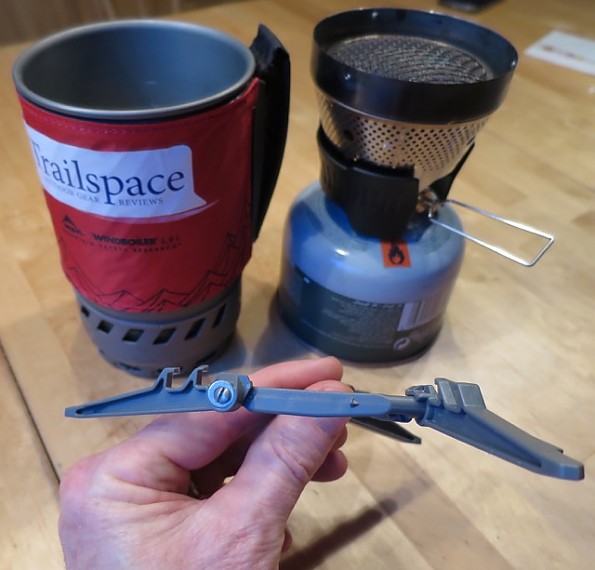

Rocket Science
The burner head itself is a thing of beauty and ingenuity, from the light gauge stainless steel windscreen to the radiant screen that glows artistically red under the blue flame when the stove is lit. The conical shape of the burner and molded plastic base give it a kind of hi-tech, rocket-engine look.
The ignition indicator wire running over the screen looks rather delicate, so in general it seems advisable to avoid rough treatment of this part of the stove. The molded plastic base serves to protect the canister mount and valve assembly when set on a hard surface.

Light My Fire
Problems with the stand aside, assembly is simple enough. You have to remember to rotate the valve control out before threading on to the canister — this idiot forgot to do that the first few times — or you will have to take it apart again to rotate the control into position.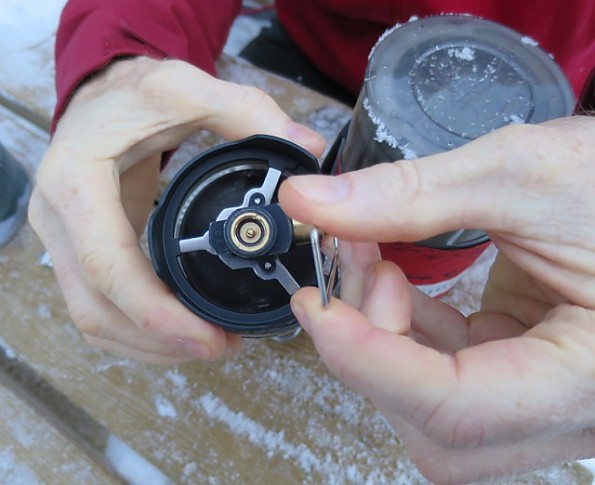
If you have a one-handed Bic-type lighter, starting the stove in low wind conditions is also simple, with one hand on the valve and the other on the lighter to spark above the screen as soon as the gas starts to flow. But if you use matches or a steel using two hands, then you have to turn on the gas before striking, and I think this is the stove’s weakness.
As it gets windier, you need a hand to shelter the burner head as you try to light it, it gets harder to get the stove to catch on the first strike, and a good stiff breeze can blow the stove out again, so you can vent a fair bit of gas just trying to get the thing lit.
It seems to me the system would be a lot more wind-resistant if it had a piezo lighter or maybe some kind of port that allowed you to light it with the pot already in place. Then there would be almost no wasted fuel at all. As it is you’ve got a stove that works flawlessly in wind, once (if) you can get it going. The manual provides no specific instructions for lighting in wind.
The manual specifically warns against lighting the stove with the pot in place or putting the pot one before the screen and ignition wire are glowing red, which only takes a few seconds. I tried it anyway, with the pot propped at a slight angle so I can light it through one of the holes at the base of the pot that are normally covered by the burner, using a butane lighter with a piezo sparker at the end of a short tube to get a little distance. But it doesn’t seem like a good idea to adopt this as a regular practice.
Instead I worked out a lighting method that involves holding the pot at an angle on the upwind side with one hand, while using the other to turn on the gas and then try to quickly light the burner. I haven’t yet tried this in full-on wind, and at any rate I think it’s up to MSR to develop and communicate a safe and reliable method for lighting the stove in wind since that is an intended use.

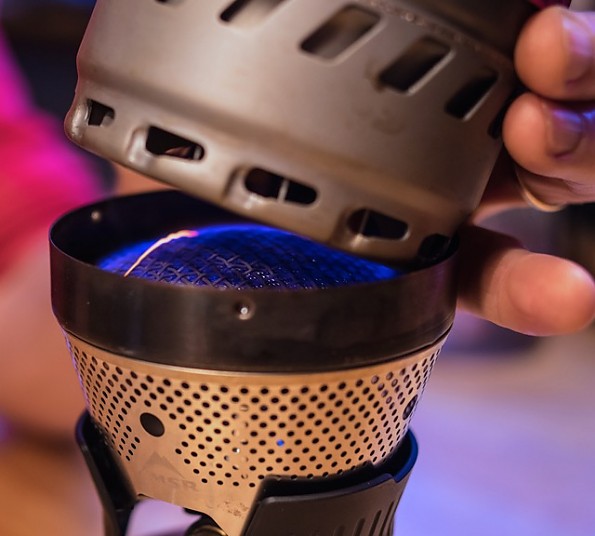
Ever since the revelatory introduction of the Whisperlite, noise level has been one of my criteria for judging a stove, and this one does well, allowing normal-volume conversation in its general vicinity. For me this is a good selling point.
One-Pot Wonder
The pot drops on and locks on to the burner with just a little twist, with no need to fiddle to find the right position. From that point on the system is pretty bombproof. It will boil 500 ml of water in not a whole lot more than the promised 2.5 minutes even in a stiff crosswind at 0˚C. In that department the Windboiler probably has no equal.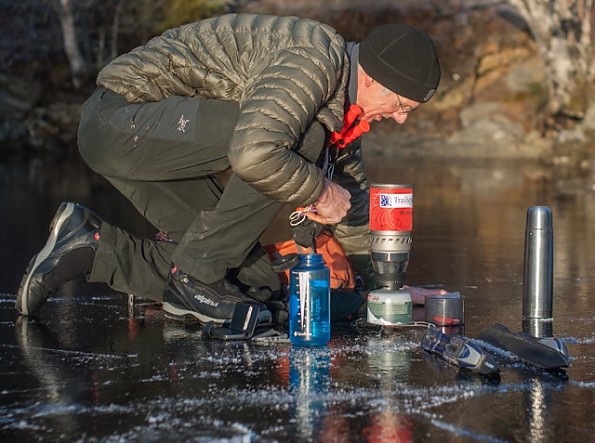
The metal that the pot is made of is not stated anywhere in the user guide or website, but it is very light and stiff; the pot with cozy but no lid weighs 208 g (7.3 oz). The spiral heat exchanger fins in the bottom of the pot are well-protected, but it might not take too much of a dent in the bottom rim to compromise the fit and lock to the stove. The plastic protector/bowl will help prevent this when stowed away in a pack.
You also don’t want to set the pot down in snow before putting it on the stove, because it can pick up a lot of snow between those fins, so it’s best to set it on the lid or something else dry; the protector/bowl is a tight fit so it’s a bit inconvenient to have to take it off at the last minute.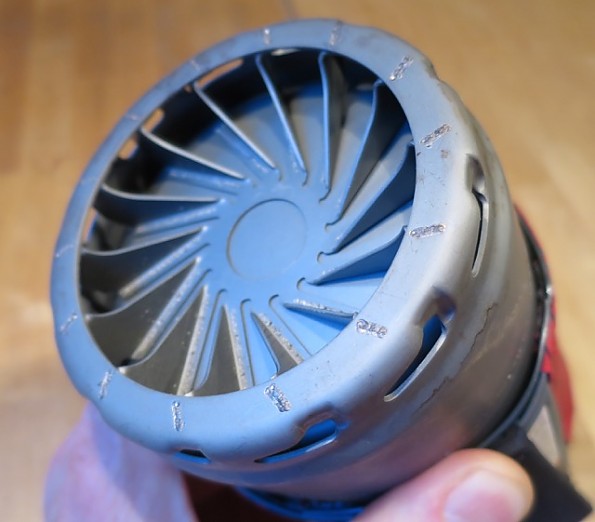
I said the pot is nominally 1 liter because there is a maximum fill line marked on the inside at 600 ml. I think that’s probably an expression of the abundance of caution required for sale, in the U.S., of just about anything an idiot like me can use to hurt himself in some imaginative way. About 1/3 of the printed area of the user guide is devoted to fine-print warnings. A not-too-idiotic user could probably get away with boiling up towards a full liter without any real risk of self-immolation.
At present there are no other pots that fit this stove, so it really is a personal stove system best used for hot drinks or freeze-dried food cooked in the bag. Boiling enough macaroni or spaghetti even for one hungry hiker would be a challenge in that small a volume, strainer lid or no. It is big enough to reach inside and scrub even if you have big hands like me. There are rumors of bigger pots on the way, but, as they are not available yet, that is beyond the scope of this review.
With the cozy, handle, and sip lid, the pot can be used as a big mug. Without the sip lid on I found the rim rather hot at first but otherwise the pot is a nice handwarmer. The thin cozy works surprisingly well at keeping contents warm. The lid is a nice tight fit and won’t come off easily in the pack, but the cozy can ride up and make it a little difficult to snap the lid on.
The 470 ml (16 oz.) bowl is characterized as “full size” but it seems a bit small to me; I think I could eat three or four fill-ups for an evening meal, especially if it involved pasta.
Too Hot to Handle
The stove has an overheating-protection mechanism that shuts off gas flow if the stove is overheated, and if it’s tripped it has to be reset using a leg of the canister stand as a tool. This by all accounts is a rare event, but the language in that part of the use manual (and repeated throughout) is rather sobering: “Note that repeated resetting of the stove may result in damage to internal components which may cause fuel to leak and cause fire, burns, severe injury, or death.”
Yikes! The field resettable feature is a big advantage over the Reactor, which has to be factory reset, but either way one hopes it is not necessary.
Not for Everyone?
It’s generally accepted that upright canister stoves are not a good choice for cold conditions, i.e. temperatures near or below freezing, because the canister will self-cool from evaporating gas, that more volatile butane will vaporize first, and the heavier gases can become too cool to vaporize properly. Having said that, this stove performed fine on a half-full canister at temperatures around freezing. It’s when you get towards the bottom of the canister that problems arise.
As with other “personal stove systems” and many alcohol stoves, the Windboiler is all about boiling water fast and efficiently and not really suitable for more complex cooking tasks. If wind performance is not a major concern for you, there are cheaper, lighter and/or more versatile stoves that will boil water at similar rates or efficiency.
If you’re planning on camping and cooking in windy environments and are content with freeze-dried or home-dried cook-in-bag meals for one or at most two people, then this highly specialized stove is a good choice. You can upgrade that to an excellent choice if you, MSR, or anyone else can figure out a reliable, no-waste way to light it in the windy situations that are otherwise its main advantage.
While the details of this system are extremely well thought-out and it functions as promised in high wind, the fragile canister stand and the lighting-in-wind problem hold it back from full marks.
Source: received for testing via the Trailspace Review Corps
(Sample provided by MSR for testing and review)
Nice compact and efficient system, some quirks need to be addressed.
Pros
- Efficient
- Compact
Cons
- Beakers get stuck
- Mantle is coming loose
- Stand vulnerable
I have used this stove on a couple of trekkings and one vacation now, sometimes carrying it in my backpack along with a tent and so on. So far I have used it for making tea, either for breakfast or to carry along in a thermos bottle.
In the future I may use it for heating water to apply inside the bag of a dried meal. That might include melting snow. I am curious how that would turn out in cold and on altitude.
Advantages for me:
- When using a 100 g cartridge, it is one compact cylindrical package which I can easily shove into my pack along similar items like a tent. That is a major advantage compared to the bulky pan I used previously, combined with either a gasoline or gas stove plus their bottle or cartridge. Of those stoves I could only put the gasoline one inside the pan, if I did so because to avoid spillage I sometimes kept that connected. So, when using that 100 g canister, I really have all in one, except for a lighter.
- The weight probably is less than any of the previous configurations I used, but I have not measured.
- Efficiency of burning, which should be a lot higher because of the build in wind shield, the heat absorbing fins underneath the pot (picture), the insulation around the pot, and the lid on the pot.
Problems I had so far:
- Number one without a doubt is the beaker getting stuck after been put around the base of the pot. It really drove me out of my mind not to be able to use the whole damn thing because of that. I have even been pulling on both ends together with someone trying to get it off. Imagine that on a freezing early morning being in a hurry. I have adapted the beaker by cutting off the three lips inside the beaker as far as I could (picture). That should help, but be aware they may still get stuck unexpectedly. The lips get stuck when the beaker is really pressed on the pot and the lips catches over an edge. That may or may not be prevented by the mantle and the lid on the pot. So as a little advice when assembling: take off the lid to get a bit more clearance. Then squeeze around every one of the lips to force it outward a bit (picture), trying to wriggle the beaker off. Yes, this is still far from ideal.
- The insulating mantle easily gets off after a while. It should be held by a lip on the mantle clipping above one on the pot. But it gets too much clearance to keep working (picture). For the time being I can block that by inserting a piece of cardboard (picture). I probably will replace that by plastic.
- Lighting the stove in wind may be tricky because the fire pit is completely exposed when lighting. Try to find shelter or to shield it some other way.
- The glowing thread above the fire pit is really handy (picture).
- Be aware the plastic stand is useful put cannot resist to much force, like when pressing the lid on the pot.
- When disassembling and putting a 100 g cartridge inside the pot, better keep the cap on to prevent damage inside the pot.
- There seems to be only one way to get everything in, including the stand: cartridge top down underneath the stove, separated by the felt, then the stand falling into the void of the stove base, finishing with the lid. It is a tight squeeze, a lighter won’t fit anymore (picture). Best is to stack the cartridge and stove first, then shove it in horizontally in the pot (picture), or put the pot over it instead of dropping it in the other way around.
Source: bought it new
Price Paid: 127 euro
This thing is great! Fast boiling, efficient, packs well.
Pros
- Self contained
- Fast
- Easy to clean
- Packs well
Cons
- Expensive
- Low volume
Setup: Quick, like less than a minute quick. The lid could fit a little better. It is really tight and feels like it could easily come off, but I frequently stuff it in a pack and it always stays put. I also use it to help pour boiling water and it has never come off.
Ignition: Leaves much to be desired. I have resorted to leaving a miniature BIC lighter inside so I am always guaranteed to have an ignition source with it.
Flame Control: Decent, doesn't simmer as well as some, but I mostly use it just to heat water for cooking or for purifying.
Cooking: Heats water SUPER fast! Melts snow, only downside is if it's below freezing it can slow down the fuel. I had been using Snow Peak iso-whatever fuel and I had to hold a lighter under the gas can to get it to heat up. (dangerous you say? don't worry it would take a lot of heat to burn through a steel canister)
Boil Time: I haven't actually timed it. I usually scoop water straight out of a river and heat it up to use in food, that way I'm not trying to drain my water bladder. It's fast though, less than 2 minutes I imagine. It also melts snow really fast too.
Fuel Efficiency: I don't cook with it like I said, only boil water. A canister lasts me quite a while. There are lots of variables.
Stability: As stable as the surface you put it on. If I have a rock or something to set it on I don't usually use the provided canister stand, but on uneven ground I do just for safety sake.
Packability: Beyond being round (weird OCD packing thing, I hate round stuff) It is a very efficient use of space. Everything fits inside, including the gas canister and a tiny lighter or piezo ignitor.
Ease of Use: So easy a cave man could do it. Why did they mess around with open fires?
Noteworthy Features: Totally windproof, I have TRIED to blow it out and let it get blown out. It's impossible.
Construction & Durability: They weak point in the system to me is the insulating jacket. Sometimes it comes off too easy. It is not possible to drop boiling water due to it slipping off, but it does get annoying at times.
Also the cup/bowl is kind of exposed, I think that if it were freezing or below and dropped on a hard surface it would crack. The pot and burner itself however are great.
Conditions: I have used this on lots of hikes, day and overnight(s). In the snow it was my sole method of melting snow. I trust it! I also bring it with me "overlanding" (fancy word for car camping but with more crap) in order to make a quick cup of tea or coffee in the morning rather than lighting up the big stove.
Source: bought it new
Price Paid: $100
I bought this stove for one purpose... to boil water high up in the backcountry in cold temps and driving wind, and this product excels.
Pros
- Super fast boil time
- Impervious to wind
- Great nesting design
- Coffee press nests inside the kit
Cons
- Sometimes difficult to tell when lit
- Goofy lid
After years of frustration with my super light backpacking stove, I had enough and started reading reviews online about stoves that would stay lit in windy conditions. The Windburner stood out in the reviews and I pulled the trigger.
This thing is amazing.... My number one priority is to boil water quickly in windy conditions in the Sawtooth mountains and the Windburner just excels at its intended purpose!! Sure it's not super light, just go to the gym more often and quit complaining.
The lid has a bit of a goofy fit, although it doesn't leak or come off, and it takes up a fair amount of pack space, but the nesting design is brilliant and MSR uses the internal space to its fullest potential. There is also a coffee press system available for this stove, and it also nests within the pot... great design.
The element on the stove is more like one of those mushroom heads on an outdoor patio heater, which is one of the design traits that makes the system work, but as others have said it is hard in wind to tell if it is lit. I have learned to just use my hearing. The stove head makes a bit of a different sound when lit than when it is just distributing gas to the head. At dusk it is much easier to tell because the head will glow.
Overall it's not a big deal because it always lights for me on the first strike of my mini-bic lighter, so I just put on the pot and let'er rip. And this thing boils FAST... at 10,000 feet in 10-12 MPH wind I can still boil 14 ounces of water in 2 minutes.
There are a couple of small quirks with this stove as I explained, but the overall design and rock solid performance of the Windburner make it an easy 5-star product for me. Being able to process water and have hot food in just a couple of minutes after pulling the stove from your pack just makes the evenings frustration-free and you can spend more time fishing and enjoying the outdoors.
Well done, MSR!
Source: bought it new
Price Paid: $100
100km p hour winds — no problems.
Pros
- Boils very quickly
- High winds are no problem for boiling
- Compact packing setup
Cons
- You need to learn how to light it in the wind
Back from a 2-day backpacking trip with this new stove. I took an almost exhausted gas cylinder (20% left). I did 4 boils of 240ml of water and the gas is still not exhausted. Boil time was 2 minutes in up to 100 km per hour winds.
The first time I started it the flame blew out before I loaded the pot / heat exchanger assembly on the stove. After this experience I learned how to keep the lighted match on the stove (waterproof matches are also WIND proof!) until the last moment before mounting the pot exchanger assembly.
Once the assembly is in place this stove is simply impervious to wind. Performs as advertised. Therefore very hard to fault.
Ideally to avoid the lighting issue (which is solvable as I said above), you could build a piezo starter into the pot/exchanger assembly base and then presto! But this would probably add to weight and expense to make it reliable and long lasting. My experience with other piezo stoves has not been good.
So all in all an excellent little windproof stove. Oh! others have commented on the tripod mount for the base. Make sure you use gas cylinders that are the correct diameter! Then no probs.
Update Jan 2 2016:
I ended up buying an all metal MSR canister tripod stand to replace the plastic one supplied with the stove. The plastic one that comes with the stove WILL break eventually. Mine hasn't yet, but I prefer to use the metal one. both are adjustable for different sized gas canisters. The metal one has a spring loaded slider which is far better than the plastic one which just has two sets of fixed slots.
Source: bought it new
Price Paid: $120 (US)
Interesting product, but is it too complicated!!
Just take a bit of time to read my detailed review before splashing out around £100.
Pros
- Very quick
- Once lit very windproof
Cons
- Had to buy Jetboil lid as original just wouldn't seat properly.
- Once it fails it's had it
- NOT field repairable if resetting trip doesn't work
OK, so I've had mine for about a year now and have loved it. It takes a bit to get it lit in blowy conditions as you've got to get the pot back on before it blows out, but once done it's like a jet aeroplane taking off.
It's been fantastic up windy exposed mountain tops, until now!! Just when I really needed a hot quick drink it decided to go on strike. Just wouldn't let gas through. Tried resetting thermal trip but jet just kept popping back up, so had no hot fluid that cold day. Have done lots of googling on the subject and most of these have to go back to USA for warranty/repair. Sod that.
I think we all believe if we can't fix it, we can't trust it when in extreme conditions. I have mine in bits now. Very tiny bits. Definitely can't be done outdoors when you need to repair it. It appears you can't buy specific parts (like a new jet, as I believe mine is blocked but you can't get in to clean it) but you have to buy a whole burner at £87!!!
So beware of the product after time as £100+is a lot to spend on a product that isn't going to become an old trusted travel companion.
Background
I've used Jetboils and cheaper highlander pot stove, both very RELIABLE, but both struggle in windy conditions.
Source: bought it new
Price Paid: £99
Good option for windy conditions.
Pros
- Efficient in wind
- Pot contains all needed items
- Easy to operate
Cons
- Can be hard to light in windy conditions
- Tall
- Not super light
This stove is a good option for windy conditions once lit, but as others have said, wind can make it tricky to light. There is no built-in igniter. Also can be hard to see that the burner has been lit, since there's no flame to provide the visual.
Easy to set up and use. A bit on the tallish side. All elements of the stove fit inside the pot, including a small canister.
Most of my canister stove experience has been with non-integrated Snow Peak or Soto stoves that weigh mere ounces, but require separate pot. Each has advantages and disadvantages and there are numerous reviews of stoves and types of stoves out there. Each has its place.
This one is good in wind, but if I don't expect that and weight is of greater interest, I'd take one of the other stoves.
Source: bought it new
Price Paid: $100
Absolutely superb!
Pros
- Closed burner
- High heat retention
- More efficient than Jetboil
Cons
- Bigger than Jetboil
- Slightly heavier
The MSR Windburner won our list of the best camping stoves for 2016! It can be summed up with one word—Spectacular!
The closed burner design means it never blows out even in high winds, at altitude, in the bitter freezing cold. This thing just powers through and will have you enjoying a lovely warm cup of coffee before you know it! Boils water at insane speeds, cans of gas seem to last forever, and it lights every time with the click of a switch.
Check out our comparison of it with the Jetboil over at http://survivalcook.com/5-best-camping-stoves-this-new-year/
Source: bought it new
Price Paid: $100
Your Review
Where to Buy
You May Like
MSR's WindBurner Stove System uses the same radiant burner technology with built-in heat exchanger that powers the Reactor stove. But, unlike the Reactor, which is meant for group use, the WindBurner is designed for personal use in punishing conditions.
The WindBurner promises "easy usability, superior boil times, and unmatched fuel efficiency in real-world conditions." MSR says it can boil 0.5 liters of water a full minute faster than the leading competition in a breeze. And, that in a 12-mph wind, it boils in 2:45, while the competition fails to boil, no matter the amount of fuel used.
Built for one to two backpackers or alpinists, the WindBurner system features a handheld design; the compact pot twists onto the windproof burner for a secure, non-slip fit.
When it debuted in 2014, the stove was originally called the WindBoiler, but its name was changed in later 2015 to WindBurner. Same stove, slightly different name.
Accessories: MSR LowDown Remote Stove Adapter, MSR WindBurner Coffee Press Kit, MSR WindBurner Hanging Kit, MSR WindBurner Personal Accessory Pot,
Specs
| Price |
MSRP: $169.95 Current Retail: $149.95-$199.95 Historic Range: $103.96-$199.95 Reviewers Paid: $100.00-$120.00 |
| Fuel |
isobutane/propane, MSR IsoPro |
| Boil time for 1 L of water |
4.5 minutes |
| Weight |
15.3 oz / 0.43 kg |
| Volume |
1.0 L |
| Width |
4.2 in / 10.5 cm |
| Length |
4.5 in / 11.5 cm |
| Height |
7.1 in / 18 cm |








